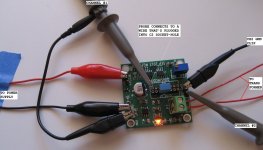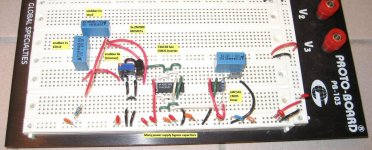A power transformer snubber is a wonderful thing for reducing or eliminating RFI from rectifier-induced LCR ringing. Unfortunately it's a huge pain to design and optimize a snubber. First you have to measure the transformer's leakage inductance and secondary capacitance, at about 100 kHz, which is not especially easy. Then you have to estimate the capacitance of your rectifier(s), which does not always appear on datasheets. Finally you plug these numbers into a formula that spits out snubber values -- and then you hope it's all correct.
Shown here is a little test jig called "Quasimodo the bell-ringer" which makes this process a great deal simpler. Quasimodo connects an actual snubber across the transformer, smacks the transformer to make it ring, and you observe the ringing on an oscilloscope. Then you adjust a (25 turn) potentiometer on the jig, watching the scope to find the setting which completely damps out all ringing. And you're done! Just use the same snubber values in the end product, as you used on the test-jig, and success is yours. (The 25 turn trimpot is socketed for ease of measuring the final resistance that gave perfect damping).
Attached are some scope waveforms showing a Quasimodo jig driving an Avel Lindberg toroidal transformer (from the Akitika GT-101 power amp). I set the trimpot to 5 different resistance values, and got the 5 traces shown. When the trimpot was removed from its socket (R = infinity), I got the black trace. A setting of Rtrimpot = 109 ohms (red trace) gave "critical damping" with no ringing: see yellow arrowhead.
Quasimodo gave an optimum snubber having critical damping (Greek letter zeta = 1.0), without requiring any calculations and without measuring the transformer's inductance or capacitance. It is a quick procedure, too: set Rtrim to max, observe waveshape on scope while reducing Rtrim, stop when all ringing is completely damped out, remove Rtrim from socket and measure it with an ohmmeter. About 3 minutes from start to finish.
This Avel Lindberg transformer has dual primaries for 115V/230V operation. So I configured the primaries the other way and ran Quasimodo again: figure attached. Not surprisingly, the optimum snubber for 230V operation is (slightly) different than the optimum for 115V operation: 120 ohms versus 109 ohms. Plus or minus the error tolerance of my ohmmeter, of course!
I've also attached a .pdf note that contains more details, schematics, construction tips, user guide, more "Quasimodo in action" scope photos, plus a bit of theory and a list of references.
EDIT 1: I had a small number of extra PCBoards + kits of all parts, which I sold at my cost, in October - December, 2013. They are all gone now, and I have no plans to sell any more. I encourage any energetic and enthusiastic diyAudio member to organize a Group Buy, using the PCB Gerber files and Bills Of Materials I provide in this thread. "CheapoModo" (a low cost version of Quasimodo) kits and PCBs are available in the Vendor's Bazaar, here.
EDIT 2: I have attached the PCB Gerber files and the Bill Of Materials, for both boards (V3_SMD, and V4_thru_hole) right here, to post #1. So now they are very easy to find!
EDIT 3: (April 2022) I just stumbled across this "Yes Math!" application note from Texas Instruments, which calculates RC snubbers to eliminate ringing from switch mode power supplies: (link)
EDIT 4: If you don't yet own an oscilloscope, post #2540 of this thread shows a cheap (USD 40) little scope toy which works for Quasimodo.
EDIT 5: Answers to frequently asked questions:
Shown here is a little test jig called "Quasimodo the bell-ringer" which makes this process a great deal simpler. Quasimodo connects an actual snubber across the transformer, smacks the transformer to make it ring, and you observe the ringing on an oscilloscope. Then you adjust a (25 turn) potentiometer on the jig, watching the scope to find the setting which completely damps out all ringing. And you're done! Just use the same snubber values in the end product, as you used on the test-jig, and success is yours. (The 25 turn trimpot is socketed for ease of measuring the final resistance that gave perfect damping).
Attached are some scope waveforms showing a Quasimodo jig driving an Avel Lindberg toroidal transformer (from the Akitika GT-101 power amp). I set the trimpot to 5 different resistance values, and got the 5 traces shown. When the trimpot was removed from its socket (R = infinity), I got the black trace. A setting of Rtrimpot = 109 ohms (red trace) gave "critical damping" with no ringing: see yellow arrowhead.
Quasimodo gave an optimum snubber having critical damping (Greek letter zeta = 1.0), without requiring any calculations and without measuring the transformer's inductance or capacitance. It is a quick procedure, too: set Rtrim to max, observe waveshape on scope while reducing Rtrim, stop when all ringing is completely damped out, remove Rtrim from socket and measure it with an ohmmeter. About 3 minutes from start to finish.
This Avel Lindberg transformer has dual primaries for 115V/230V operation. So I configured the primaries the other way and ran Quasimodo again: figure attached. Not surprisingly, the optimum snubber for 230V operation is (slightly) different than the optimum for 115V operation: 120 ohms versus 109 ohms. Plus or minus the error tolerance of my ohmmeter, of course!
I've also attached a .pdf note that contains more details, schematics, construction tips, user guide, more "Quasimodo in action" scope photos, plus a bit of theory and a list of references.
EDIT 1: I had a small number of extra PCBoards + kits of all parts, which I sold at my cost, in October - December, 2013. They are all gone now, and I have no plans to sell any more. I encourage any energetic and enthusiastic diyAudio member to organize a Group Buy, using the PCB Gerber files and Bills Of Materials I provide in this thread. "CheapoModo" (a low cost version of Quasimodo) kits and PCBs are available in the Vendor's Bazaar, here.
EDIT 2: I have attached the PCB Gerber files and the Bill Of Materials, for both boards (V3_SMD, and V4_thru_hole) right here, to post #1. So now they are very easy to find!
EDIT 3: (April 2022) I just stumbled across this "Yes Math!" application note from Texas Instruments, which calculates RC snubbers to eliminate ringing from switch mode power supplies: (link)
EDIT 4: If you don't yet own an oscilloscope, post #2540 of this thread shows a cheap (USD 40) little scope toy which works for Quasimodo.
EDIT 5: Answers to frequently asked questions:
- Build guide for V3 (SMD) is found in post #27
- Build guide for V4 (thru hole) is found in post #103
- 2 hour build time, quick-and-dirty Quasimodo on solderless protoboard (no PCB!) is found in post #18 and in (the CheapoModo thread)
- Substitute parts recommendations are found in the Bill Of Materials
- How to choose a MOSFET besides the ones in the BOM, is found in post #175
- How to check your own BOM before purchasing components, is found in post #203
- diyAudio members who have ordered their own sets of PCBoards from a PCB fab, using the Gerbers provided here, include: gazzagazza, luvdunhill, Borges, stormsonic, cwtim01, normundss, dsolodov, EUVL, kissmurphy, stephengrenfell, Piersma, SyncTronX, yoaudio, andrensairr. You can PM them to find out how easy or difficult it was.
Attachments
-
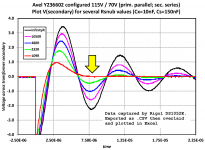 Avel_USA.png78.5 KB · Views: 29,169
Avel_USA.png78.5 KB · Views: 29,169 -
 Avel_Europe.png70.1 KB · Views: 29,238
Avel_Europe.png70.1 KB · Views: 29,238 -
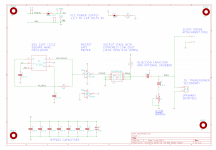 Quasimodo_V3_SMD_sch.png48.6 KB · Views: 30,449
Quasimodo_V3_SMD_sch.png48.6 KB · Views: 30,449 -
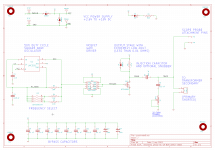 Quasimodo_V4_TH_sch.png47.7 KB · Views: 30,577
Quasimodo_V4_TH_sch.png47.7 KB · Views: 30,577 -
Quasimodo_jig_revA.pdf817.4 KB · Views: 11,920
-
QuasimodoSMD_Gerbers_and_everything_else.zip104.7 KB · Views: 2,619
-
Quasimodo_TH_Gerbers_and_everything_else.zip347.1 KB · Views: 3,686
Last edited:
Mark,
Nice test jig and excellent application note.
It surprises me that many people who you would expect to know better do not understand that it is the resistor that does the snubbing and not the capacitor. The capacitance across the secondary (or across the rectifiers) only changes the ringing frequency and the capacitor in series with the snubber resistor is only there to limit its dissipation.
Somewhat of an evangelist for snubbers, I had been using the parametric measurement and calculation process for years and only recently turned to an in-circuit empirical approach similar to yours.
I now use Cx = 220n and Cs = 100n on all my snubbers and simply adjust a 2k single turn potentiometer to find the Rs value for optimum damping. However I do this in the actual, live circuit at close to the rated load current (I have some very large 10R resistors).
Final point is that the snubber components need to be located as close to the transformer as possible for the best results.
Nice test jig and excellent application note.
It surprises me that many people who you would expect to know better do not understand that it is the resistor that does the snubbing and not the capacitor. The capacitance across the secondary (or across the rectifiers) only changes the ringing frequency and the capacitor in series with the snubber resistor is only there to limit its dissipation.
Somewhat of an evangelist for snubbers, I had been using the parametric measurement and calculation process for years and only recently turned to an in-circuit empirical approach similar to yours.
I now use Cx = 220n and Cs = 100n on all my snubbers and simply adjust a 2k single turn potentiometer to find the Rs value for optimum damping. However I do this in the actual, live circuit at close to the rated load current (I have some very large 10R resistors).
Final point is that the snubber components need to be located as close to the transformer as possible for the best results.
Great work !! 
It's true that there's still lots of half-whisdom out there, even when you look at commercial gear.

It's true that there's still lots of half-whisdom out there, even when you look at commercial gear.
Hello Mark J (?), nice work, and thanks for your your thorough documentation.
Recently I got hold of a variable frequency/variable voltage regenerative AC power supply http://www.kikusui.co.jp/kiku_manuals/P/PCR_L_E7.PDF to try/prove a few experiments.
First on the list was to explore power supply frequency dependence of typical consumer level audio gear.
Subjective testing reveled that 50Hz supply sounded best with 50Hz recordings, 60Hz supply sounded best with 60Hz recordings...lowered non musical intermod products is the resultant, but 55Hz (which is musically related) sounded best regardless of supply or recording supply frequency.
With optimal snubbing this ought to be a moot point, but of course with typical audio gear none of this optimisation is implemented, and PSU ringing will crash straight through any PSRR, sub optimal earthing arangements further exacerbating the products/problems.
To extend the discussion, IME optimal snubbing applied directly across speaker drivers, and then further across the input terminals of loudspeakers to achieve flat impedance characteristic pays huge sonic dividends...most amplifiers measure well into resistance loads, but many can go sour when driving reactive loads.
Snubbing is a far too frequently ignored subject, and IME/IMO of paramount importance.
Regards, Dan.
Recently I got hold of a variable frequency/variable voltage regenerative AC power supply http://www.kikusui.co.jp/kiku_manuals/P/PCR_L_E7.PDF to try/prove a few experiments.
First on the list was to explore power supply frequency dependence of typical consumer level audio gear.
Subjective testing reveled that 50Hz supply sounded best with 50Hz recordings, 60Hz supply sounded best with 60Hz recordings...lowered non musical intermod products is the resultant, but 55Hz (which is musically related) sounded best regardless of supply or recording supply frequency.
With optimal snubbing this ought to be a moot point, but of course with typical audio gear none of this optimisation is implemented, and PSU ringing will crash straight through any PSRR, sub optimal earthing arangements further exacerbating the products/problems.
To extend the discussion, IME optimal snubbing applied directly across speaker drivers, and then further across the input terminals of loudspeakers to achieve flat impedance characteristic pays huge sonic dividends...most amplifiers measure well into resistance loads, but many can go sour when driving reactive loads.
Snubbing is a far too frequently ignored subject, and IME/IMO of paramount importance.
Regards, Dan.
Last edited:
Here's a photo of Quasimodo V.3 in operation. The 25 turn trimmer RV1 is clearly visible (dark blue box, upper right), and so is the injection capacitor C2 (light blue box, center), plugged into its socket with many pins. You also can see the three 8pin SOIC packages. It's a two layer board and if you look around you can find some vias. Frontside fill is VCC, backside fill is GND.
Attachments
Thanks, guys.
I have just used snubbers on a SMPS and got excellent results: http://www.diyaudio.com/forums/power-supplies/240563-real-simulation-parasitics-13.html#post3645351
(In post #123)
Dan,
Practically, there must be some wire length between the transformer and the rectifier diodes that will be about 50nH to 200nH.
I did a bit of LTSpice simulation on this model and I remember I made the assumption that the CRC snubber need to be cloose to the diodes instead of the transformer. So your point now makes me to re-examine my previous assumption.
Could you please elaborate a bit more?
Regards,
Bill
I have just used snubbers on a SMPS and got excellent results: http://www.diyaudio.com/forums/power-supplies/240563-real-simulation-parasitics-13.html#post3645351
(In post #123)
Final point is that the snubber components need to be located as close to the transformer as possible for the best results.
Dan,
Practically, there must be some wire length between the transformer and the rectifier diodes that will be about 50nH to 200nH.
I did a bit of LTSpice simulation on this model and I remember I made the assumption that the CRC snubber need to be cloose to the diodes instead of the transformer. So your point now makes me to re-examine my previous assumption.
Could you please elaborate a bit more?
Regards,
Bill
Close to the transformer is wise because this is where the tank circuit that is storing energy is located, in the leakage inductance and the inter-winding capacitance. We dissipate that energy at the source. The diodes do not radiate the ringing as RF, it is large structures like transformers and wiring that do the radiating. And in any case, the voltages and currents across the diodes when snubbed become nice and softly rounded no matter where the snubber is, and this is because the power factor at the ringing frequencies is now resistive.
Looking at the finite impulse response in the time domain is a cool way to work out the damping resistance. This gave me a grin, as my experience looking at problems from this angle comes from working on PSTN line echo cancellation DSP software with adaptive filters to work out the finite impulse response of any echo coming back to you so you can produce a replica and remove it.
Definitely adding it to my bag of tricks!
Definitely adding it to my bag of tricks!
Mark,
considering the test circuit that you use, is there anything special about its layout considerations? I would like to make (etch or point to point) a board with it, so I am curious.
considering the test circuit that you use, is there anything special about its layout considerations? I would like to make (etch or point to point) a board with it, so I am curious.
If you use a gate driver IC that pumps out a LOT of current, you'll want to make short, wide, low-inductance traces for its power and ground connections. I built a 49mm x 49mm PCB (for seeed's lowest price) and used 40 mil (1.02 mm) wide traces & numerous bypass capacitors. The attachment "Quasimodo_V3_SMD_sch.png" connected to post#1 on this thread, shows its the schematic.... is there anything special about its layout considerations? I would like to make (etch or point to point) a board with it, so I am curious.
I also built a prototype of Quasimodo on solderless breadboard, and it worked quite acceptably: see photo here. The "gate driver" was six 74AC04 logic inverters connected in parallel, giving 6 x 24mA output current.
Attachments
Quasimodo V.3 SMD uses 0.15uF 100V ceramic capacitors, X7R dielectric, 1206 package. I happened to purchase them from DigiKey, I picked Samsung CL31B154KCHNNNE (link). As the design note says on page 22,
For Quasimodo V.4 Thru Hole, I gave myself permission to use different capacitor values in different positions, since leaded capacitors have markings that tell you their value. The supply bypass capacitors I chose were Kemet X7R ceramics, 0.1uF, 100V, 0.1 inch lead spacing. I bought these at DigiKey (link).For ease of pick-and-place with SMD capacitors (which are unmarked!) I chose a single capacitance value to be used in every capacitor position: 0.15 microfarads. The oscillator timing capacitor is 0.15uF, the 555 control voltage bypass capacitor on pin 5 is 0.15uF, and all seven of the supply bypass capacitors are 0.15uF. With only one value capacitor for the entire board, it's impossible to solder a wrong value cap in the wrong position.
- Home
- Amplifiers
- Power Supplies
- Simple, no-math transformer snubber using Quasimodo test-jig
